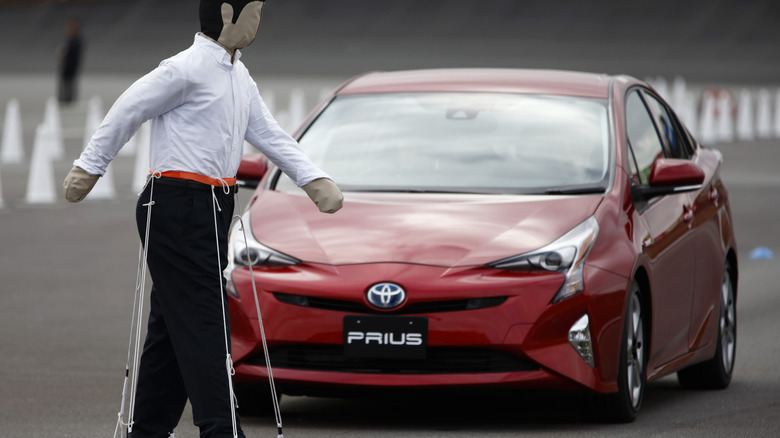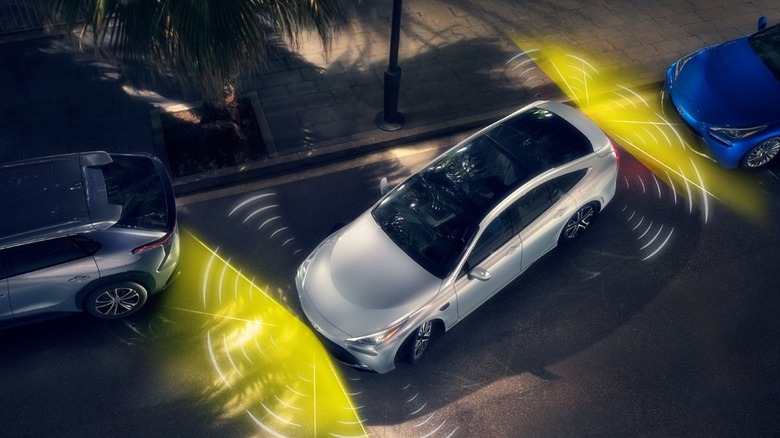Here's How Toyota's Advanced Driver Assistance Systems Helps Keep You Safe
Japanese auto giant Toyota introduced the Toyota Safety Sense (TSS) advanced driver assistance systems in 2015 with three primary functions: automatic high beam, lane departure alert, and a pre-collision system. Moreover, the system came with a forward-facing camera and a millimeter-wave radar to include other functionalities like adaptive cruise control and road sign assist.
The latest generations of Toyota Safety Sense (TSS 2.5 and 2.5+) have enhanced features to prevent or mitigate collisions, keep vehicles centered on the lanes, and deliver enhanced safety when driving in the dark. The game plan is to make road accidents a thing of the past through continuously evolving technology. Toyota debuted its most advanced ADAS technology, Toyota Teammate, in 2022 in the second-generation Toyota Mirai FCEV, and it has more driving tech to keep occupants safe. The latest Toyota Teammate also includes a Level 2 hands-free driving technology and an automatic parking feature to make driving more convenient and fun.
Toyota Safety Sense 2.5 and 2.5+: How does it work?
The latest Toyota Safety Sense (TSS) versions, 2.5 and 2.5+, have six core functions that unlock even more capabilities for a safer drive. The pre-collision system can detect vehicles and pedestrians in daytime and low-light scenarios. Moreover, it detects bicyclists in the daytime while providing visual and audible alerts to warn the driver. If the system detects no action from the driver, it applies automatic braking to stop the car.
Furthermore, the pre-collision system now includes intersection support and emergency steering assist. The former detects vehicles and pedestrians when making a left or right-hand turn. At the same time, the latter helps stabilize the vehicle when the driver makes an emergency maneuver to avoid obstacles.
Meanwhile, TSS 2.5 and 2.5+ include full-speed dynamic radar cruise control with low-speed following, stopping, speed matching, acceleration, and deceleration functions. For TSS 2.5+, curve speed management is included and uses the camera and built-in yaw sensors to reduce the vehicle speed when tackling curves. Other TSS features include lane tracing assist and road sign assist.
Toyota Teammate
Toyota debuted the second-gen Toyota Mirai in 2022 as the brand's first production vehicle to get a standard Toyota Teammate with more ADAS capabilities. It features two new core functions – Advanced Drive and Advanced Park – that first saw action in the Lexus LS 500h for the 2022 model year.
Advanced Drive enables Level 2 semi-autonomous, hands-free driving on selected highways like GM's Super Cruise and Ford's BlueCruise. In addition, Advanced Drive can keep the vehicle within the lane, follow other cars, change lanes, or perform overtaking maneuvers. Advanced Park uses circumferential cameras and 360-degree ultrasonic sensors to park the vehicle with zero driver intervention, including parallel parking duties.
The automotive industry is still a revolution away from unlocking Level 4 or Level 5 full self-driving automation. Rising inflation and global conflicts have forced experts to delay the commercialization of self-driving cars by 2035, but good news is on the horizon. Level 3 autonomous cars will most likely arrive in showrooms in mid-2025, and Level 4 autonomous vehicles will follow soon after. Until then, advanced driving assistance systems are the next best thing.

